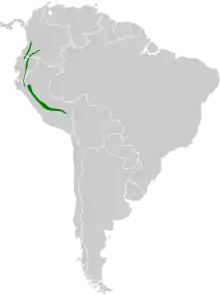Golden-collared honeycreeper
The golden-collared honeycreeper (Iridophanes pulcherrimus) is an uncommon species of Neotropical bird in the tanager family Thraupidae. It is the only member of the genus Iridophanes.
| Golden-collared honeycreeper | |
|---|---|
 | |
| Male in Ecuador | |
| Scientific classification | |
| Domain: | Eukaryota |
| Kingdom: | Animalia |
| Phylum: | Chordata |
| Clade: | Dinosauria |
| Class: | Aves |
| Order: | Passeriformes |
| Family: | Thraupidae |
| Genus: | Iridophanes Ridgway, 1901 |
| Species: | I. pulcherrimus |
| Binomial name | |
| Iridophanes pulcherrimus (P.L. Sclater, 1853) | |
 | |
| Synonyms | |
| |
It is found in Colombia, Ecuador, and Peru. Its natural habitats are subtropical or tropical moist montane forests and heavily degraded former forest.
Taxonomy
The golden-collared honeycreeper was formally described in 1853 by the English zoologist Philip Sclater from a specimen collected near Bogotá in Colombia. He coined the binomial name Tangara pulcherrima.[2][3] It is now the only species placed in the genus Iridophanes that was erected by Robert Ridgway in 1901.[4][5] The genus name Iridophanes combines the Ancient Greek iris meaning "rainbow" and -phanēs meaning "showing". The specific epithet pulcherrimus is Latin for "very beautiful".[6]
A molecular phylogenetic study of the tanager family published in 2014 found that the golden-collared honeycreeper and the green honeycreeper (Chlorophanes spiza) were sister species.[7]
Two subspecies are recognised:[5]
- I. p. pulcherrimus (Sclater, PL, 1853) – central Colombia through east Ecuador to south-central Peru
- I. p. aureinucha (Ridgway, 1879) – west Colombia to northwest Ecuador
References
- BirdLife International (2016). "Iridophanes pulcherrimus". IUCN Red List of Threatened Species. 2016: e.T22722961A94795653. doi:10.2305/IUCN.UK.2016-3.RLTS.T22722961A94795653.en. Retrieved 12 November 2021.
- Sclater, Philip (1853). "Description de deux nouvelles espèces d'oiseaux". Revue et Magasin de Zoologie Pure et Appliquée. 2nd series (in French). 5: 480.
- Paynter, Raymond A. Jr, ed. (1970). Check-List of Birds of the World. Vol. 13. Cambridge, Massachusetts: Museum of Comparative Zoology. pp. 385–386.
- Ridgway, Robert (1901). "New birds of the families Tanagridae and Icteridae". Proceedings of the Washington Academy of Sciences. 3: 149–155 [150].
- Gill, Frank; Donsker, David; Rasmussen, Pamela, eds. (July 2020). "Tanagers and allies". IOC World Bird List Version 10.2. International Ornithologists' Union. Retrieved 23 October 2020.
- Jobling, James A. (2010). The Helm Dictionary of Scientific Bird Names. London: Christopher Helm. pp. 207, 324. ISBN 978-1-4081-2501-4.
- Burns, K.J.; Shultz, A.J.; Title, P.O.; Mason, N.A.; Barker, F.K.; Klicka, J.; Lanyon, S.M.; Lovette, I.J. (2014). "Phylogenetics and diversification of tanagers (Passeriformes: Thraupidae), the largest radiation of Neotropical songbirds". Molecular Phylogenetics and Evolution. 75: 41–77. doi:10.1016/j.ympev.2014.02.006. PMID 24583021.
